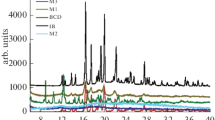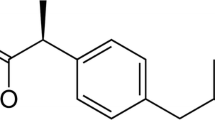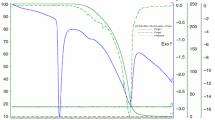Abstract
The main objective of this work was to use the differential scanning calorimetry in conjunction with optical microscopy to study the compatibility of ibuprofen with lactose and polyvinylpyrrolidone and to provide an explanation(s) for the reduction in the dissolution rate observed from the ternary interactive mixture containing ibuprofen in previous study. Mixtures containing micronized ibuprofen–fine lactose 90:10 and 20:80 w/w showed a decrease in the melting peak of lactose by 14.33 and 10.94 °C, respectively. The addition of 5 % fine lactose to the binary system has the highest effect on the melting point of ibuprofen by reducing the melting peak of ibuprofen from 76.2 to 73.72 °C. Microphotographs obtained from optical microscopy for ibuprofen, binary and ternary interactive mixtures showed that agglomeration of ibuprofen was formed in the binary and ternary interactive mixtures. Lactose and polyvinylpyrrolidone must be avoided in the preparation of ternary interactive mixtures of ibuprofen to prevent drug–excipient interaction.




Similar content being viewed by others
References
Saharan V, Kukkar V, Kataria M, Gera M, Choudhury P. Dissolution enhancement of drugs. Part I: technologies and effect of carriers. Int J Health Res. 2009;2:107–24.
Patel R, Nirav P, Patel N, Patel M. A novel approach for dissolution enhancement of ibuprofen by preparing floating granules. Int J Res Pharm Sci. 2010;1:57–64.
Rasenack N, Müller B. Ibuprofen crystals with optimized properties. Int J Pharm. 2002;245(1–2):9–24.
Abrahamsson B, Lennernas H. Application of biopharmaceutic classification system now and in the future. In: Waterbeemd HVD, Lennernas H, Artursson P, editors. Drug bioavailability. Weinheim: Wiley; 2003. p. 495–531.
Charoenchaitrakool M, Dehghani F, Foster NR, Chan HK. Micronization by rapid expansion of supercritical solutions to enhance the dissolution rates of poorly water-soluble pharmaceuticals. Ind Eng Chem Res. 2000;39:4794–802.
Perrut M, Jung M, Leboeuf F. Enhancement of dissolution rate of poorly-soluble active ingredients by supercritical fluid processes: part I: micronization of neat particles. Int J Pharm. 2005;288(1):3–10.
Andreou JG, Stewart PJ, Morton DAV. Short-term changes in drug agglomeration within interactive mixtures following blending. Int J Pharm. 2009;372(1–2):1–11.
Bolten D, Türk M. Micronisation of carbamazepine through rapid expansion of supercritical solution. J Supercrit Fluids. 2012;62:32–40.
Pinto EC, Carmo FA, Honório TD, Barros R, Castro HCR, Rodrigues CR, et al. Influence of the efavirenz micronization on tableting and dissolution. Pharmaceutics. 2012;4(3):430–41.
Rasenack N, Mueller BW. Micron-size drug particles: common and novel micronization techniques. Pharm Dev Technol. 2004;9:1–13.
Allahham A, Stewart P. Enhancement of the dissolution of indomethacin in interactive mixtures using added fine lactose. Eur J Pharm Biopharm. 2007;67(3):732–42.
Allahham A, Maswadeh H. Study of dissolution kinetics for poorly water-soluble drugs from ternary interactive mixtures in comparison with commercially available capsules. J Pharm Innov. 2014;9(2):106–14.
Hecq J, Deleers M, Fanara D, Vranckx H, Amighi K. Preparation and characterization of nanocrystals for solubility and dissolution rate enhancement of nifedipine. Int J Pharm. 2005;299:167–77.
Merisko-Liversidge E, Liversidge GG, Cooper ER. Nanosizing: a formulation approach for poorly-water-soluble compounds. Eur J Pharm Sci. 2003;18:113–20.
Ruan LP, Yu BY, Fu GM, Zhu DN. Improving the solubility of ampelopsin by solid dispersions and inclusion complexes. J Pharm Biomed Anal. 2005;38:457–64.
Lacasse FX, Hildgen P, McMullen JN. Surface and morphology of spraydried pegylated PLA microspheres. Int J Pharm. 1998;174:101–9.
Jinno J, Kamada N, Miyake M, Yamada K, Mukai T, Odomi M, Toguchi H, Liversidge GG, Higaki K, Kimura T. Effect of particle size reduction on dissolution and oral absorption of a poorly water-soluble drug, cilostazol, in beagle dogs. J Control Release. 2006;111:56–64.
Yoshikawa S, Murata R, Shida S, Uwai K, Suzuki T, Katsumata S, Takeshita M. Evaluation of correlation between dissolution rates of loxoprofen tablets and their surface morphology observed by scanning electron microscope and atomic force microscope. Chem Pharm Bull. 2010;58(1):34–7.
Abbas D, Kaloustian J, Orneto C, Piccerelle P, Portugal H, Nicolay A. DSC and physico-chemical properties of a substituted pyridoquinoline and its interaction study with excipients. J Therm Anal Calorim. 2008;93(2):353–60.
Pani N, Nath L, Acharya S, Bhuniya B. Application of DSC, IST, and FTIR study in the compatibility testing of nateglinide with different pharmaceutical excipients. J Therm Anal Calorim. 2012;108(1):219–26.
Bruni G, Amici L, Berbenni V, Marini A, Orlandi A. Drug-excipient compatibility studies. Search of interaction indicators. J Therm Anal Calorim. 2002;68(2):561–73.
Dumitru T, Tunde J, Adriana F, Eleonora M, Bogdan T. Compatibility study of the acetylsalicylic acid with different solid dosage forms excipients. J Therm Anal Calorim. 2013;112(1):407–19.
Mura P, Faucci M, Manderioli A, Bramanti G, Cevvarelli L. Compatibility study between ibuproxam and pharmaceutical excipients using differential scanning calorimetry, hot-stage microscopy and scanning electron microscopy. J Pharm Biomed Anal. 1998;18:151–63.
Mura P, Manderioli A, Bramanti G, Furlanetto S, Pinzauti S. Utilization of differential scanning calorimetry as a screening technique to determine the compatibility of ketoprofen with excipients. Int J Pharm. 1995;119:71–9.
Botha SA, Lotter AP. Compatibility study between oxprenolol hydrochloride, temazepam and tablet excipients using differential scanning calorimetry. Drug Dev Ind Pharm. 1990;16:331–45.
Marini A, Berbenni V, Pegoreti M, Bruni G, Cofrancesco P, Sinistri C, Villa M. Drug excipient compatibility studies by physic chemical techniques. The case of atenolol. J Therm Anal Calorim. 2003;73:547–61.
Bogdan T, Ionut L, Geza B, Dumitru T. Compatibility study between indomethacin and excipients in their physical mixtures. J Therm Anal Calorim. 2014;118(2):1293–304.
Maillard LC. Action of amino acids on sugars. Formation of melanoidins in a methodical way. Comp Rend. 1912;154:66–8.
Wirth DD, Baertschi SW, Johnson RA, Maple SR, Miller MS, Hallenbeck DK, Gregg SM. Maillard reaction of lactose and fluoxetine hydrochloride, a secondary amine. J Pharm Sci. 1998;87:31–9.
Danehy JP. Maillard reactions: non-enzymic browning in food systems with specific reference to the development of flavour. Adv Food Res. 1986;30:77–138.
Abdoh A, Al-Omari MM, Badwan AA, Jaber AM. Amlodipine besylate-excipients interaction in solid dosage form. Pharm Dev Technol. 2004;9(1):15–24.
Ledl F, Schleicher E. New aspects of the maillard reaction in foods and in the human-body. Angew Chem Int. 1990;29(6):565–94.
Mauron J. The maillard reaction in food; a critical review from the nutritional standpoint. Prog Food Nutr Sci. 1981;5(1–6):5–35.
Desai S, Shaikh M, Dharwadkar S. Preformulation compatibility studies of etamsylate and fluconazole drugs with lactose by DSC. J Therm Anal Calorim. 2003;71:651–8.
Misra M, Misra AK, Panpalia GM. Interaction study between pefloxacin mesilate and some diluents using DSC supported with isothermal method. J Therm Anal Calorim. 2007;89(3):803–8.
Tiţa B, Fuliaş A, Bandur G, Marian E, Tiţa D. Compatibility study between ketoprofen and pharmaceutical excipients used in solid dosage forms. J Pharm Biomed Anal. 2011;56(2):221–7.
Pignatello R, Spadaro D, Vandelli MA, Forni F, Puglisi G. Characterization of the mechanism of interaction in ibuprofen–Eudragit RL100 coevaporates. Drug Dev Ind Pharm. 2004;30:277–88.
Cory WC, Harris C, Martinez S. Accelerated degradation of ibuprofen in tablets. Pharm Dev Technol. 2010;15:636–43.
Kararli TT, Needham TE, Seul CJ, Finnegan PM. Solid state interaction of magnesium oxide and ibuprofen to form a salt. Pharm Res. 1989;6:804–8.
Sarisuta N, Lawanprasert P, Puttipipatkhachorn S, Srikummoon K. The influence of drug-excipient and drug-polymer interactions on butt adhesive strength of ranitidine hydrochloride film-coated tablets. Drug Dev Ind Pharm. 2006;32:463–71.
Hartauer K, Arbuthnot G, Baertschi S, Johnson R, Luke W, Pearson N, Rickard E, Tingle C, Tsang P, Wiens R. Influence of peroxide impurities in povidone and crospovidone on the stability of raloxifene hydrochloride in tablets: identification and control of an oxidative degradation product. Pharm Dev Technol. 2000;5:303–10.
Sekizaki H, Danjo K, Eguchi H, Yonezawa Y, Sunada H, Otsuka A. Solid state interaction of ibuprofen with polyvinyl-pyrrolidone. Chem Pharm Bull. 1995;43:988–92.
Renu C, Kapoor V, Kumar A. Analytical techniques used to characterize drug-polyvinylpyrrolidone system in solid and liquid states. J Sci Ind Res. 2006;65:459–69.
Bogdanova S, Pajeva I, Nikolova P, Tsakovska I, Muller B. Interaction of pol(vinylpyrrolidone) with ibuprofen and naproxen: experimental and modeling studies. Pharm Res. 2005;22:806–15.
Supabphol R, Stewart P. Aggregation during the dissolution of diazepam in interactive and granulated mixtures. Pharm Pharmacol Commun. 1996;2(5):233–6.
Acknowledgements
I would like to thank Prof. Shahid Akbar (director of the research center, College of pharmacy, Qassim University) for his support.
Author information
Authors and Affiliations
Corresponding author
Rights and permissions
About this article
Cite this article
Maswadeh, H.M. Incompatibility study of ibuprofen in ternary interactive mixture by using differential scanning calorimetry. J Therm Anal Calorim 123, 1963–1971 (2016). https://doi.org/10.1007/s10973-015-4773-z
Received:
Accepted:
Published:
Issue Date:
DOI: https://doi.org/10.1007/s10973-015-4773-z




